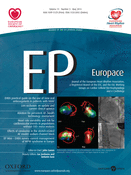Europace:单腔心房起搏器植入术后升级率及并发症发生率高
2013-04-30 Europace dxy
Danish多中心临床研究是一项比较病态窦房结综合征患者植入双腔起搏器(DDDR)和单腔心房起搏器(AAIR)临床疗效的对照研究。与DDDR相比,植入AAIR的患者存在起搏器术后升级的风险,起搏器升级是指通过外科手段改变起搏模式。AAIR起搏器虽然适用于病态窦房结综合征患者,但对于房室传导阻滞却没有保护作用,如果患者出现了房室传导阻滞则需要起搏器升级,目前关于起搏器升级的并发症发生率还不清楚。
Danish多中心临床研究是一项比较病态窦房结综合征患者植入双腔起搏器(DDDR)和单腔心房起搏器(AAIR)临床疗效的对照研究。与DDDR相比,植入AAIR的患者存在起搏器术后升级的风险,起搏器升级是指通过外科手段改变起搏模式。AAIR起搏器虽然适用于病态窦房结综合征患者,但对于房室传导阻滞却没有保护作用,如果患者出现了房室传导阻滞则需要起搏器升级,目前关于起搏器升级的并发症发生率还不清楚。
据此,Kirkfeld RE等在Europace上发表了一篇临床研究,该研究的目的如下:明确AAIR升级的并发症发生率,明确起搏器升级的预测因子,描述AAIR升级相关并发症的发生情况。
Danish研究共入选1415例病态窦房结综合征患者,其中707例植入AAIR,平均随访时间为5.5年。根据患者起搏器随访病例资料了解患者起搏器升级及并发症的相关信息,采用多因素Logistic回归分析探讨起搏器升级的预测因子。结果显示,共有66例患者进行了起搏器升级,升级率为9.3%,其中59例患者具备起搏器升级的I类适应症。单因素回归分析显示年龄和左心房增大是起搏器升级的预测因素,但多因素分析显示没有任何一项临床因素是起搏器升级的独立预测因素。在66例患者中,11例在起搏器升级过程中出现了并发症,并发症的发生率高达16.7%。
根据该项研究可得出以下结论:多数需起搏器升级的患者具备起搏器升级的I类适应症,起搏器升级相关并发症的发生率高,根据目前的结果,目前仍推荐病态窦房结综合征的患者植入DDD起搏器,而不建议植入VVI起搏器。
与起搏器相关的拓展阅读:
- Circulation:起搏器再利用安全可行
- 西京医院实施国内首例“肠道起搏器”治疗顽固性便秘
- AHA2012年会:TAVI同行起搏器置入不改善生存率
- JAMA:心脏起搏器可改善1型肌强直性营养不良患者生存率
- 清华脑起搏器论坛:关注帕金森病
- 清华脑起搏器论坛:关注帕金森病 更多信息请点击:有关起搏器更多资讯

System upgrade and its complications in patients with a single lead atrial pacemaker: data from the DANPACE trial
Aims
To investigate the indications for system upgrade with single lead atrial pacing (AAIR), complications associated with these re-interventions, and possible predictors for system upgrade among patients included in the Danish Multicenter Randomized Trial on AAIR vs. dual-chamber pacing (DDDR) in sick sinus syndrome (DANPACE).
Methods and results
A total of 707 of 1415 patients were randomized to AAIR pacing. Mean follow-up was 5.5 ± 2.6 years. Information on indications for system upgrade and complications were collected by reviewing patient charts. Multiple logistic regression was used to estimate adjusted odds ratios (aOR) with 95% confidence intervals (CI) for the association between predictors and system upgrade. Sixty-six patients (9.3%) in the AAIR group underwent system upgrade. Fifty-nine of these patients (89.3%) had a documented class I indication for system upgrade. Age (aOR 0.98 for each 1-year increase in age; 95% CI 0.6–1.0), and left atrial enlargement (aOR 1.9; 95% CI 1.0–3.8) were predictors for system upgrade. No single clinically applicable predictor for upgrade was identified. A total of 11 patients (16.7%) experienced at least one major complication after system upgrade.
Conclusion
The majority of patients with AAIR pacing who underwent system upgrade had a class I indication. The incidence of major complications after system upgrade was high. The present data support the use of DDDR pacing rather than AAIR pacing in sick sinus syndrome.
作者:Europace
版权声明:
本网站所有注明“来源:梅斯医学”或“来源:MedSci原创”的文字、图片和音视频资料,版权均属于梅斯医学所有。非经授权,任何媒体、网站或个人不得转载,授权转载时须注明“来源:梅斯医学”。其它来源的文章系转载文章,本网所有转载文章系出于传递更多信息之目的,转载内容不代表本站立场。不希望被转载的媒体或个人可与我们联系,我们将立即进行删除处理。
在此留言





#发生率#
23
#ACE#
27
#并发#
31
#起搏器#
30
#植入#
29